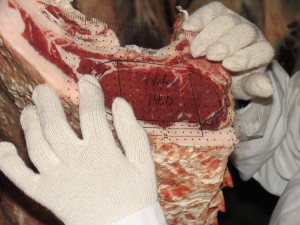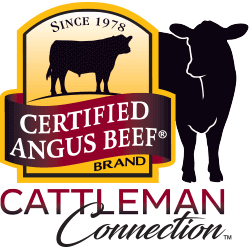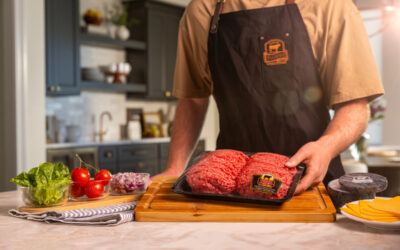
Grading 101

The concept of quality grading was first tested when the government ordered meat for the troops, way back during World War I. Following the war, quality grades became a widespread purchasing tool. In 1963, yield grades were added to the mix to, as you might expect, predict red meat yield. While both tools have been improved on over the years, the system remains very similar to the original concept.
Here are 3 things you need to know about this time-tested method:
1. It’s fast. In a matter of 10 to 15 seconds, a USDA Agricultural Marketing Service agent assigns a carcass with ink stamps representing its yield grade, quality grade and evaluation for an export market or branded program (like the Certified Angus Beef® brand).
2. When quality counts, marbling and maturity matter. For a carcass to receive a Choice or Prime quality grade, it has to look like it’s going to have exceptional taste. That means a high marbling score (lots of those white specks of intramuscular fat we talk so much about) and a youthful determination based on lack of ossification on the chine bones. These two factors are our most powerful indicators of flavor and tenderness.
3. Yield grades measure cutability, or usefulness of the carcass. Just how much of that carcass can end up on someone’s dinner table versus what’s left on the packing plant floor or byproducts. The lower the number, the higher the value. Therefore, a Yield Grade 1 carcass is much more desirable than a Yield Grade 5 carcass because it contains substantially more marketable product.
Want more? Well, you’re in luck. Just about three years ago, we produced an overview on beef carcass grading, chock full of examples and graphics. Even better? It’s available for free download here or you can order hard copies (also free!) by filling out the form under “Educational Resources” here.
And if you still have questions? Let us know! We’d love to answer them. This is kind of our thing.
PS–Obviously grading is pretty darn valuable to all of us in the beef business and there’s recent controversy as to whether that government function will continue as usual this spring. If you haven’t heard the latest drama, you can check out this Drovers Cattlenetwork link to get caught up.
You may also like
Success, Despite Challenges
Today’s market is complex and competitive. The collective effort of stakeholders across the supply chain positions Certified Angus Beef to meet the record demand for premium beef moving forward. Signals across the beef industry are clear and Angus farmers and ranchers seeking high-quality genetics that deliver premium beef are producing a product in high demand.
Keep the Supply Coming
A record-high 800 registrants from 17 countries gathered in Austin, Texas, to learn more about CAB, become inspired by the culinary work of chefs and pitmasters, and celebrate sales and production success. But at the forefront: supply and demand, a reflection of the chaotic past year, and preparing for what’s ahead.
Consumer Demand, Power of Quality
Demand for high-quality beef persists. But with that demand comes challenges. From tight cattle supplies to higher costs and increasing pressure on retailers to deliver a consistent eating experience, the pressure is on. David O’Diam, CAB VP of retail, addressed the current retail beef environment, highlighting both opportunities and challenges in today’s marketplace.



